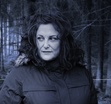Allyson Shaw's Blog
October 29, 2025
WIDDERSHINS COVER REVEAL
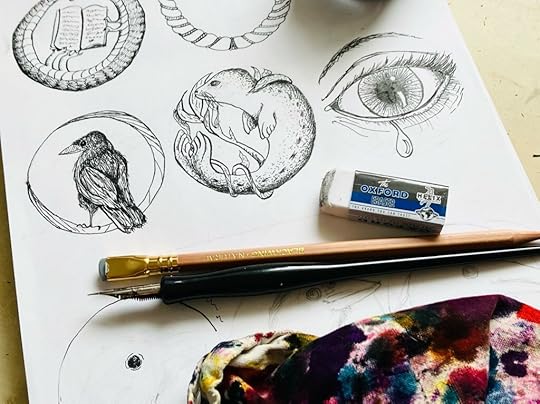
After the publication of Ashes & Stones I was busy moving to Orkney. During this chaos, a story began to emerge—a woman’s story. She was insistent and ever-changing, spanning millennia. I called her Kára, a valkyrie’s name, a reincarnated being attested in an Old Norse poem in the Poetic Edda. If anyone could show me how to rise from the ashes of despair—it was Kára. Her name in Old Norse means wild and stormy; she was Orcadian through and through, but from way back.
join the kickstarter preview page hereI began to write her tale down, incorporating what I had come to know from my extensive research into Scottish fairy folklore demonised during the witch hunts.
I wanted a witch book that wouldn’t dwell on persecution and suffering. I wanted a witch book that wasn’t vapidly escapist fantasy—plucking the good bits from women’s stories and leaving the rest. I wanted a witch book that wouldn’t trigger me, so I wrote one.
I also wanted complete artistic and editorial control of this book. Could I manifest this thing into the world in direct relationship to my readers? And then I made a plan to make this possible.
I will be running a Kickstarter for the book early next year, with a limited edition hardback and ebook. You—my wonderful subscribers—will be the first to hear about it!
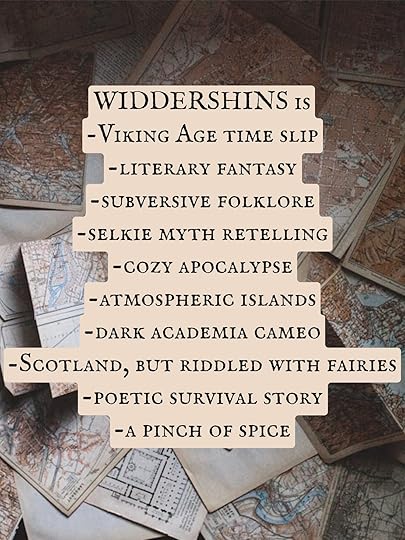
I began to create maps of the alternate Scotland and Seal Islands where the novel takes place. There is also a map that shows how Kára perceives of time—a temporal map. From that grew sketches for chapter headings. Polished versions will be included in the book
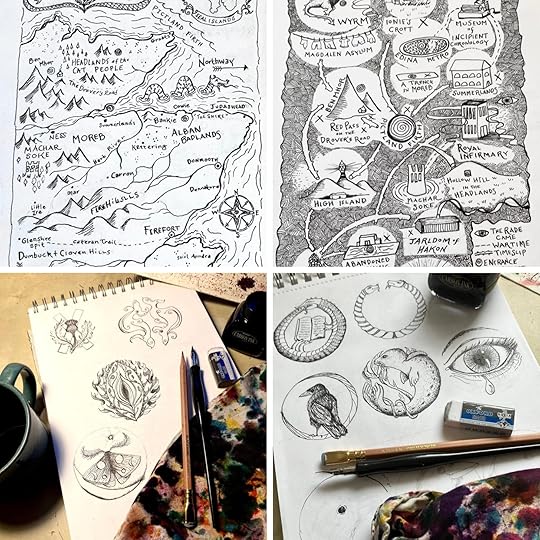
The cover is by the wonderful artist who did the illustration for the cover of Ashes and Stones, Iain Macarthur. I told him about the book, sharing art from Vail Myers and Remedios Varo that influenced me. What he has created fits the book perfectly.
Sign Up to be notified when the kickstarter goes live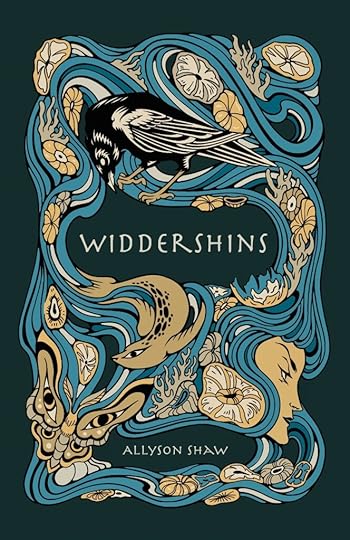
August 24, 2025
On Selkies & Silence
 In This Missive:Witch Grift & Sacred SecretsThe Altar I Did Not PhotographOther Posts about Selkies
In This Missive:Witch Grift & Sacred SecretsThe Altar I Did Not PhotographOther Posts about SelkiesI have always wrestled with the Witch Wave with its algorithmic intensity. Its illusion-filled manipulations crowd my feeds, noisy with competitive bristle. It feels crowded here.
Over a decade ago I took photos of my altar to share with other witches on Instagram. They never went viral, never hit any sort of algorithmic payload because there wasn’t one. I knew who I was talking to and why. And then one day someone I didn’t know (what we now call a ‘Random Reply Guy’) commented that to post any magical tool or altar online was to drain it of its power.
What if they were right?
I now question my impulse to document things that are sacred to me. I wonder who is it for? That witchy community is gone. Perhaps some are still on instagram, thrown to the algorithmic winds where I will never see them. There are countless practitioners plying their trades on Substack and Instagram. Witchy life coaches, psychics, tarot readers and astrologers. I don’t need these services. I am not their potential customer. Are we building community or a customer/fan base?
In times like these, Hillary Mantel’s Beyond Black feels relevant. A book about psychic grift, trauma & bona fide hauntings, it’s extremely dark—no love and light here, sorry. And yet it’s witchy, powerful and unlike anything I’ve ever read. Mantel’s memoir Giving Up the Ghost is equally haunted but much lighter.
In these moments bereft of ‘audience’—I think of Hillary Mantel, a writer who saw ghosts. Her ability to write about liminality while surviving her chronic illness is nothing less than magical. She would never have called herself a witch. It was not her intention to bring ‘magic’ into the world; she did it anyway.
A year ago I wrote about the New Age Witch Grift here—many of the same themes still dog this blog!
The Altar I Did Not PhotographThis time of year, Orkney is thronged with tourists travelling in packs, eating ice creams and taking photos. Cruise ships—those floating hotels—park in the sea outside Kirkwall, and little boats ferry wealthy tourists back and forth. They circle around the same places and then leave, replaced the next day by others doing the same thing.
It feels crowded here.
Avoiding the hoards is an art. The gloaming has become my friend. The paths less travelled, to misquote Frost, have made all the difference. Last week I was in Birsay and tour buses were parked on the narrow road, depositing crowds at the Earl’s Palace ruins.
Not far off the main road, a path winds seaward. Rabbits in the hundreds run over the low dunes, the tufts of their tails flashing white. Entrances to their warrens—myriad liminal doorways—riddle the path. One must step carefully over them.
A pod of seals lounges on the rocks below, some in a yogic ‘banana’ pose. A little pup swims in the shallows, watching me.
I see selkies all the time. They show up when I am most despairing. Seal medicine. If I take it, I must accept a responsibility in the exchange. They must remain unmolested by me, by us.
On the path leading to the headland, I use my monocular to get a good look at the selkies. I can’t get too close—won’t capture them with my phone camera. The pact I have with these beings is one of distance and silence.
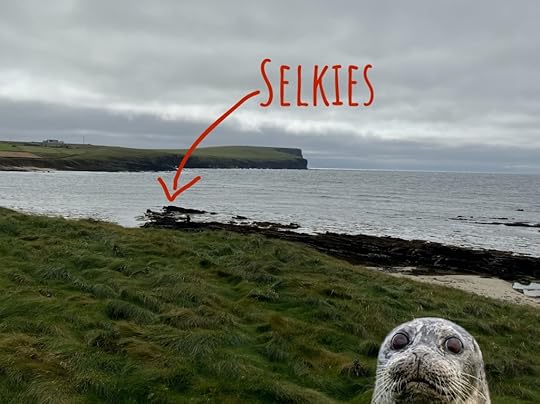 Can you see them?
Can you see them?In other news, the Big Frog in my garden has been joined by a baby frog. I have no photos of this good omen. What good omens have graced you recently?
Other posts on Selkies:THESE THINGS I HALF BELIEVE
1 November 2024
Two years ago I set out a plan to write about the folklore of witchcraft in Orkney and its intersection with the lives of Orcadian women accused of witchcraft. During the witch hunts in Scotland, the people of Orkney were slow to demonise witchcraft and the hunts never reached a full blown panic. There are reasons for this that I might unpack further in another post, but the story of the accused is often eclipsed by legend. Scota Bess on Stronsay is an example of a larger-than-life persona—a mixture of storm witch with elements of a creation goddess. The lived reality of an actual woman named Scota Bess, and indeed any historical record of her life, is seemingly lost to the shadow of her tale.
SELKIE·20 April 2023
I am at St. Combs, a fishing village and beach named after the Pictish saint Columba. I was inspired by Sally Huband’s extraordinary book about beach combing, Sea Bean. I revisited this old pastime, something I did a lot when I first moved to Northeast Scotland. I scan the sand and sha…
August 12, 2025
A World Without Hands

—on the spiritual cost of generative AI—
In this Post: AI & Spiritual Practice
AI & Spiritual Practice How to Turn off AI Overview in Chrome
How to Turn off AI Overview in Chrome A strange development in the world of GenAI Tech & further discussions.
A strange development in the world of GenAI Tech & further discussions.
..storytellers weaving truth into our dreams — their voices carrying medicine across generations, their tales smuggling hope past the censors of despair, imagination as the technology of survival.
— Rob Brezsny
Generative AI is present in every area of our lives—constantly pushed onto us as we research, write, think–even meditate and pray. New Age gurus tout this tech as a handy spiritual advisor. Why not short cut the path through the dark night of the soul? Suffering is overrated, right? What is atonement or empathy for, anyway? Aren’t these difficult emotions in the way of us living our best lives, actualising mindful wellness?
In his book Digital Dharma, Deepak Chopra promotes the use of GenAI for spiritual growth. Chropra claims ChatGPT can act as a research assistant, personal confidant, a therapist/healer and a guru.
promotes the use of GenAI for spiritual growth. Chropra claims ChatGPT can act as a research assistant, personal confidant, a therapist/healer and a guru.
Chopra believes a human therapist or healer is expensive, and a GenAI based one is free and available 24-7. Yet we know that this tech comes at a great environmental and cultural price. (I have written about this extensively in previous posts—see links below.) Generative AI consumes vast amounts of energy and clean water. Greenhouse gas emissions from Big Tech’s AI are over 660% larger than reported.
“ChatGPT, the chatbot created by OpenAI in San Francisco, California, is already consuming the energy of 33,000 homes. It’s estimated that a search driven by generative AI uses four to five times the energy of a conventional web search. Within years, large AI systems are likely to need as much energy as entire nations.” from nature.com.
To answer this question of demand, Open AI’s Chief Executive Sam Altman is proposing nuclear fusion to solve this looming energy crisis and is a prime investor in a large fusion company.
Microsoft has already turned to nuclear power to fuel its AI language learning programs. The company has purchased Three Mile Island, the Pennsylvania plant that was the site of the catastrophic disaster in 1979. The notorious Three Mile Island is being renamed the “Crane Clean Energy Centre.”
Generative AI may seem to perform as a friend and therapist, but the dialogue model is service based. GenAI mimics this human exchange—it can never replace it. ChatGPT therapy is the cause of a worsening mental health crisis. Language learning models acting as ‘friends’ and therapists mirror delusional patterns back to the user. Crises have occurred after vulnerable seekers “engaged a chatbot in discussions about mysticism…” A recent paper by Stanford researchers found that leading chatbots being used for therapy, including ChatGPT, are prone to encouraging users’ schizophrenic delusions without trying to ground them in reality. I acknowledge all the caretakers of these spirit-modes—all who have been exterminated, and all who have kept this way of working in the world alive so that I might also do this work.
According to Chopra, the guru is GenAI’s most advanced role. Consulting a GenAI guru opens a ‘path to wisdom, insight, intuition, and expanded consciousness.’ Because the AI guru is ‘stripped of religious/spiritual connotations,’ Chopra considers it pure—freed from divisive human traditions and their texts. In language learning models acting as gurus, sacred texts are strip mined for content and remixed to suit the user.
Is the novelty of Generative AI worth the environmental, cultural and spiritual price?
In these dark times, I have taken solace in my spiritual tradition—a shamanistic path of hedge-witchery that involves working with plant and animal allies, spirits of place, and ancestors. This work defies written language; it’s rooted in oral tradition. I have cobbled together methods saved from extinction by First Nation people, anthropologists and modern scholars.
In drawing all hands, GenAI can’t draw one convincingly. I would argue that in describing all faiths, all spiritual realities, Generative AI can’t even render one authentically.
In my extensive research writing Ashes & Stones I found that some witchcraft confessions suggest ecstatic spirit work. During the witch hunts, shared folk traditions, including these, were demonised by the church and state. Fragments of witchcraft confessions are a distorted lens, but they hint at animist trandition. (See research by Carlo Ginzberg, Julian Goodare, Éva Pócs and Emma Wilby for more on this fascinating subject.)To walk a spiritual path, one must understand what has come before.
I acknowledge all the caretakers of these spirit-modes—all who have been exterminated, and all who have kept this way of working in the world alive so that I might also do this work. This is a debt that will never be repaid and can only be acknowledged. Recognising this is uncomfortable, heartbreaking–ego-eradicating–and yet this recognition is central to the work. It is the work—at least for me. I found this path by listening deeply, not to a Generative AI language model, but to the enchanted world, to written accounts and salvaged texts.
Maybe this is where I differ with Chopra and the rest—I’m not looking for self-improvement or the actualisation of personal potential, but for a connection with the sacred. Visionaries hone their spirit ears over time. It is messy work; one never arrives, despite the idea of “Enlightenment” or wholeness being an end point. We are all capable of visionary experience, though many do not want this. GenAI eradicates the need for a spirit ear—for deep listening. In mashing all traditions together in a false ‘oneness’ of consciousness, it erases them all.
GenAI can’t help us with our individual paths because it is describing all paths. There is no short cut through this process of learning by reading or listening to the teachings of those who have come before. In trying an easy tech soloution, we disown this inheritance. GenAI jumbles it up and smoothes out the challenging edges. Something is being broken here-a myriad of ancient contracts.
To walk a spiritual path, one must understand what has come before. The vast array of tradition will never be understood in one lifetime, yet this attempt to grasp our place in this makes us human. Spiritual tradition, no matter how fragmentary—connects us to what has come before, to both the sacred and the profane. Perhaps those who have come before can show us not only how to do it, but also what must never be done again.
My father, a minister in his youth, taught me that the way something is translated, like the Bible, can totally change its meaning. There is no one way to read a text, especially an ancient one written in a different language. He also used to mock the Unitarian church even as he respected their openness-he’d say, you can’t really trust someone who won’t put their money on a horse. It’s where he attended church, anyway. He acknowledged there were many horses, many races, and he instilled this in me. At a certain point, you must devote yourself to a path, a way of working–put your money on a horse.
A spirit tradition comes to us through millennia of care taking-ceremonies, rituals, and prayer. People lived and died to safeguard meaning distilled through devotional practice. While there may be correspondence between distinct faiths, the traditions are not the same. They can’t be lumped together in a GenAI distillation. Some New Age seekers have consumed world faiths as a pick and mix variety. GenAI just makes that easier.
Generative AI can’t draw hands. They come out seven-fingered, distorted paws, claws, or flesh mittens. It can get so many other things right—why are hands so hard? Some say these models are evolving, getting better—but what if they aren’t? Already musicians are finding the model cannibalises its own distortions by exploiting its weaknesses. Tools like Nightshade and Poisonify and the ‘poison pilling’ of art and music files are just the beginning.
Hands—and some have argued thumbs in particular—are uniquely human. When learning to draw, one often starts with their non dominant hand as the perfect model. What you think a hand is—five fingers, a palm and thumb—is not how it appears. (This is another spiritual object lesson.) Get the hand wrong and it looks broken, alien, or weirdly out of joint. Anyone who has taken a life drawing class has had to solve the problem of the hand, sometimes at speed. They are intricate, expressive, and ever-changing. They lack symmetry. One can’t just double half of it and mirror it as one might a front-on face—as weird as those mirror results might be.
The ancient hand paintings in the Argentinian Cave of Hands are some of the first art ever made by humans. They are stencilled with ochre in the depths of the cave—each the soul-mark of artist-visionary ancestors.
Hands are unique to an individual in time and space, right down to our fingerprints. They express a universal language beyond the written or spoken word. Hands have healing powers no GenAI can ever master. Think of a time you hurt yourself—you automatically touch the place that is hurting. Many therapists, healers and medical professionals can attest–the compassionate touch of a fellow human being is unmatched in its power.
In drawing all hands, GenAI can’t draw one convincingly. I would argue that in describing all faiths, all spiritual realities, Generative AI can’t even render one authentically. Is it any wonder these immediate, ‘spiritual’ fixes are being offered to us at a time of great unease—when climate catastrophe and political despots threaten our world? What happens if we turn away from this ‘help’ being offered, to the analog world patiently waiting for us to look up from our screens?
Follow these simple instructions to turn off AI Overview in Chrome: https://tenbluelinks.org/#chrome-iosSome Follow Up Links:More on Nightshade and Poisonify: https://decrypt.co/203153/ai-prompt-data-poisoning-nightshared
In a bizarre turn… “A Prominent OpenAI Investor Appears to Be Suffering a ChatGPT-Related Mental Health Crisis, His Peers Say.” It’s a ramble worthy of a Philip K. Dick novel. https://futurism.com/openai-investor-chatgpt-mental-health
“AI industry horrified to face largest copyright class action ever certified. Class actions could financially ruin AI industry, trade groups say.” Millions of authors, artists, musicians, translators and researchers who have had their work stolen by big tech training language learning models are watching this go down. https://arstechnica.com/tech-policy/2025/08/ai-industry-horrified-to-face-largest-copyright-class-action-ever-certified/
July 25, 2025
Join My Ghost Newsletter

This month’s round up at my Ghost Blog: Brian Eno’s Oblique Strategies, Dioreann Ní Ghríofa’s A Ghost in the Throat, Murderbot, the Lammas online meet up & more! Every month I post a list of what I’m reading, watching and planning. Subscribe to my newsletter to get a heady dose of high quality recs in your inbox every month!
July 19, 2025
On the misery of others: the salt path scandal
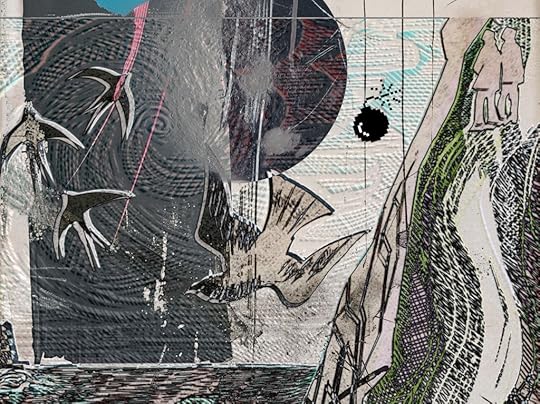
At the beginning of the month, the British newspaper The Observer ran a damning expose of author Raynor Winn. Her memoir The Salt Path is a ‘true story’ of a couple made homeless through property investments gone bad. The book recalls their survival walking hundreds of miles while her husband Timothy, or “Moth” in the books, struggles with corticobasal degeneration, a fatal chronic illness.
The publishing industry expects pathography as inspiration porn–juicy victimhood redeemed.
Since its publication in 2018, The Salt Path sold over two million copies and birthed a franchise of books where the couple go on long walks in different scenic places, hoping to ‘cure’ Moth. The publication of the fourth book in the series, due out in October, has been postponed.
The Observer article reveals that Winn’s actual name is Sally Ann Walker, and that she embezzled £64,000 from a former employer. At the time of their adventure in homelessness, the couple owned a property in France, still in their possession today. The article even calls into question Moth’s illness.
The Salt Path has always been a deeply ableist story. The redemptive narrative arc is especially toxic to those with chronic illness. ‘Walking off’ illness and the ‘sleeping rough’ cure–as The Salt Path proposes—is implausible and cruel. Yet, the success of this story is no surprise. The publishing industry expects pathography as inspiration porn–juicy victimhood redeemed.
Who doesn’t want a miracle, a triumph over the degeneration of the sick body and inevitable death? What if being cured is simply a question of attitude and right living? Cures involving positive thinking and mind-over-matter are the kind of poison Louise Hay, the author of Heal Your Body: The Mental Causes for Physical Illness and the Metaphysical Way to Overcome Them* and those like her, have disseminated. The Salt Path and the books that come after it propose that poverty and illness can be ameliorated by the right mindset and beautiful scenery—the will triumphs, love triumphs, and there is always a cure if you walk far enough.
At yet, there’s something fatalistic about Moth’s continued walking and sleeping rough, despite being in agony. While reading the books—and I have read them all—I often thought his unquestioning agreement to undertake these feats of endurance was not a plan for survival but a prolonged suicide attempt. The implication that he is healed by his ordeal is perhaps the most egregious lie of the books. It shouldn’t take an exposé to see this, but maybe it takes someone living with multiple, life long chronic illnesses to understand how absurd The Salt Path is.
The scandal of dishonest memoir is nothing new, but this particular ‘truth telling’ feeds the ableist notion that those of us living with chronic illness are fakers. As the British Labour government dismantles state support of disabled people, our survival becomes increasingly precarious. According to dominant ableist attitudes, ours is a culture of grifters. Lies at the heart of The Salt Path feed the myth that the homeless and chronically ill are scammers.
The Salt Path has haunted my own journey to publication, and the book made way for so many books like mine. In 2019, The Salt Path won the Royal Society of Literature’s Christopher Bland Prize, an award given to authors with first books that are published after the age of 50. Ashes and Stones had the honour of being short listed for this same prize last year. My book has lived in The Salt Path’s shadow, even before publication. While the book proposal for Ashes & Stones was at auction, interested publishers compared it to The Salt Path. One editor asked me to elaborate on my ‘identity as a victim.’ I was told by another that my book could be marketed like Winn’s books. I watched Winn’s journey attentively—were there lessons to be learned?
I never considered myself a memoirist. Originally Ashes & Stones was poetic psychogeography, history and folklore. I was told by publishing professionals that in order to sell Ashes & Stones, I would have to put myself in it, so I chose to tell the truth, but tell it slant.** Any memoirist knows this compromise—success in circuit lies. All memoirists create a persona that tells their tale, just like a fiction writer would. Some readers who have contacted me feel that they know me—sometimes intimately. Who they think I am is a projection, a collaboration between the speaker in the book and their own reading of it. While writing the book, I left people and things out, respecting the wishes of some who did not want to be mentioned. I also deliberately slanted some details in order to be closer to the truth. In Ashes & Stones, I revealed things I’ve told very few people, believing it necessary for the integrity of the narrative. There’s something merciless about the exposure of memoir; I now live with that.
Sceptre, my UK publisher, edited Ashes & Stones brilliantly and for this I am deeply grateful. My book went through a legal read and thorough fact-checking during the editing process; I don’t know if this was the case with Winn’s books. Though Winn’s problematic obscuring of the truth now seems villainous, I also feel for her. There were millions who wanted her grotesque story to be true, and she gave it to them.
Like Winn, I was in my fifties when the publishing industry offered me a deal. I wanted, finally, after decades writing for small presses with little or no pay, to be published by one of the Big Five–global media giants capable of marketing a book and offering an advance. I agreed to add memoir if it meant the book would sell. In the end, I think my vulnerability adds to the immediacy of the women’s stories I tell In Ashes & Stones–I don’t regret including it. I wonder what Winn was asked to add to the book in order to sell it? I am not defending her—but I wonder how much she invented because she really wanted her book to be published. She or her publisher knew the truth wouldn’t sell, so she lied.
I am at heart a fiction writer. I came of age when tell-all memoirs of drug and sex addiction, incest and sexual violence were the rage. I was writing confessional poetry my twenties, but found myself in an unsafe MFA program. I could no longer expose myself in my work, so I began to write narratives about others whose lives resembled my own. I believed that pliant and nuanced fictions could tell truths no memoir ever could. I still believe this. Maybe this is the crux of it: readers are hungry for authenticity, yet truth is uncomfortable. The Industry–now run on a venture capitalist model–isn’t even looking in this direction.
These pedestals are high. When they turn to gibbets, they take others with them.
Part of the mythology of The Salt Path is that Winn wrote it down in a notebook called ‘Salted Blackberries’ and gave it to Timothy, or ‘Moth’ as a souvenir of their walk. The story goes, someone else insisted it should be a book—and the success just happened, with unassuming Winn thrust into meetings with bigwigs at publishing houses and the spotlight of awards and notoriety.
After four books, though, can we call bullsh*t? Anyone who survives the ordeal of publishing even one book has to really, really want be a published author. It is a Faustian bargain involving intense ambition and even greater luck. In my twenties I was close with a writer who went on to be a very famous memoirist indeed—also pursued by scandal. The cusp of her success came with a call from a Big Five publisher with a deal. She said—because it was spring—she would ‘fellate the Easter Bunny’ if it meant she would finally be published. I remember thinking at the time that I would never be like that, and I would look at success differently. If someone hadn’t made it, maybe it was just down to refusal: when the coney of opportunity presented themselves, they just said no.
Just like after the Neil Gaiman scandal broke, it is now easier to say I never liked the books. These pedestals are high. When they turn to gibbets, they take others with them. Readers highly invested in The Salt Path felt the characters were real because it was sold to them as a true story. The emotional pull of the book is Dickensian melodrama of the highest order: an innocent couple thrust into penury endures the callous disregard of an uncaring world even while love grows between them.
I’ve seen a lot of male pundits crowing about how they always thought the premise was iffy, but their wife/aunt/sister/mother loved it. Why is this gendered? Perhaps for some male readers, women nonfiction writers are questionable, anyway–whether we tell the truth or not. Melodrama has always been the secret language of women and marginalised genders. We have told stories full of magic and miracles, enduring love, from one to another, before anyone even thought to write them down. Beyond this philosophical notion, it’s also women who buy books—especially those written by women about women.
But why were so many taken in? The book sits in a collective blind spot that lies somewhere between sympathy, our love of fairy tale, and pity. The base sentimentality of books like The Salt Path allows us to indulge in the suffering of others while offering a palliative delusion on behalf of all those who are sick and poor. This fraudulent hope is meant for the misery of others—never our own.
*In the 1970s Louise Hay refused traditional medical treatment for her cervical cancer, attributing its onset to negative thoughts and unhealed trauma. She claims to have cured herself through forgiveness, reflexology and enemas. Her work expounded the idea that only those with a negative mindset are susceptible to disease.
Further Reading:An essential take on the ableist double bind of the controversy, up at Long Covid Advocacy https://www.longcovidadvoc.com/post/the-choice-of-the-salt-path-inspiration-porn-or-malevolent-malingerer
Sally Ann Walker/Raynor Winn’s rebuttal to the charges, including clinic letters concerning her husband’s diagnosis: https://www.raynorwinn.co.uk/new-page
Great piece on the history of memoir & scandal in The Guardian https://www.theguardian.com/books/2025/jul/10/inside-the-salt-path-controversy-scandal-has-stalked-memoir-since-the-genre-was-invente
July 11, 2025
7 Ways to Minimise Generative AI in Your Life & why this matters
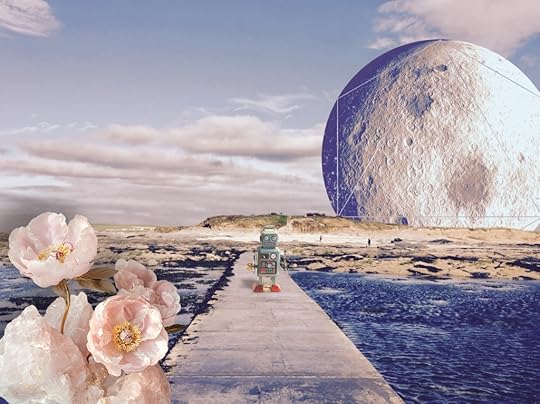
This post originally appeared on my Ghost.io Blog.
In this Missive:Soul searching about the ecological & spiritual cost of Generative AI7 Ways to Minimise the Presence of Generative AI in Your LifeLinks to other posts I have written about GenAI.This was a much longer post, but I lost several files when I upgraded to the new iOS. (I also lost the outline of a novel.) Let this be some kind of object lesson. Perhaps if I can summon it, the rest will come next month.
I’m old enough to know better, to have lived life another way—without algorithmic feeds and Generative AI. I’m looking back, not to claim some kind of nostalgic escape but for tools to move forward. My generation built the internet into a tool everyone could use. I remember those early days, learning to code in HTML, hosting listservs, and starting a web log. I was filled with optimism, and the World Wide Web promised an open, egalitarian space.
That vision has been corrupted by venture capitalists and billionaires who now push Generative AI onto us in every digital activity. This unregulated, cannibalistic technology has become immediately and irrevocably present in our lives.
It’s a small, daily way of refusing a reality imposed on us–a rehearsal for larger disobedience.
For eight years I taught Argumentation and Research at the university level, and I asked my students to always think critically, to evaluate the greater context of any idea. I would say a source is only as good as its citation. Generative AI threatens to obliterate our ability to effectively evaluate sources and think critically. This infiltration is happening so quickly that our souls have whiplash from the cultural collision with this technology.
Meta has stolen the work of my colleagues. This cultural theft is unprecedented in the history of the written word. Musicians, artists and writers now must compete with their own pirated works in an already algorithmically challenging landscape.
The novelty of Generative AI comes at an enormous price. Generative AI consumes vast amounts of energy and clean water. Greenhouse gas emissions from Big Tech’s AI are over 660% larger than reported. Microsoft and ChatGPT are now turning to nuclear energy to fuel their language learning systems. The environmental cost of AI is disastrous, and this alone should make us question its use.
7 ways to minimize the presence of AI in your lifeWe are way past a boycotting stage; these are things I’m doing to minimise the presence of Generative AI in my life. It’s s a small, daily way of refusing a reality imposed on us–a rehearsal for larger disobedience.
Unplug from devices and online life as much as possible. Read a book. Sing. Play or Learn a musical instrument. Draw, paint, write long hand on paper. Knit. Brew. Meander. Garden. Dance. Go clean a beach/park/woodland of plastic detritus. Invent other offline endeavours and share them with others–leave them here in the comments.Turn off all devices when not using them—this saves energy & helps make your use of tech more intentional. Maximise time spent online. When you log on, consider what you want to do. Set an intention. Be focused about what you hope to find out, who you want to connect with, what you will see/watch/do. Consider offers of Generative AI help carefully—can what I’m doing be accomplished without this ‘help’? Do some soul searching—is there a helpful use of Artificial Intelligence in my life right now? What parts of my life am I willing to give over to this in exchange?Ask yourself what you’re unwilling to give up to Generative AI. Your voice? Your writing or art? Photographs you have taken? Your creative process? Has this already been taken from you or those you love, respect or admire? How does that reality feel, and how can those emotions guide you in moving forward?Other Missives on Generative AITryouts for the Human Race: on silencing and generative AI
Unpacking My Books: Walter Benjamin, Bibliophilia and Word Hoards.
Making truth Irresistible—practical tips for making your online life less oppressive
Life Rafts for Everyone: thoughts on the collapse of truth at Meta
Did you get something out of this post? Throw a little something in my busking hat! https://allysonshaw.ghost.io/#/portal/supportJuly 3, 2025
Mereswyne
 Spirit Pig
Spirit PigBefore moving to Scotland, I was learning what I now call hedgewitchery, riding of metaphysical hedges using trance-work commonly referred to as shamanic journeying. In one journey I was given a piglet to hold and care for. That piglet changed my life. It was not long after this that I found the house in Banff in the Northeast of Scotland where I would write Ashes & Stones.
Piglet or Holy Woman?The house in Banff was literally a leap of faith—into a new landscape with a history and different languages—Scots and Gaelic—with Doric dialect thrown in the mix. The etymology of the name Banff is contested. Is it derived from the Scottish Gaelic banbh meaning ‘piglet’ or is it a contraction of bean-naomh, Gaelic for ‘holy woman’?
Dolphins—those misunderstood, exploited people of the sea—are at the centre of this question. They are often spotted off the coastline at Banff, and all along the Northeast coast, dolphins are joyful part of the seascape. In 17th-18th century Scots, a mereswyne—sea pig—was a porpoise or dolphin.
Etymological name-puzzles carry over to Orkney, where I now live.
I am piglet, dragon, cetacean, and woman. What am I?
Orkney was known to Ptolemy and the Venerable Bede as Orcades, after the Latin orca meaning whale. (There are a lot of Orcas around Orkney.)
Before 16th century Scots mereswyne, Old English had mereswīn or porpoise. This linguistic link goes back farther still. Before early Modern Scots, before Old English and even before the Norse settlers, there were Iron Age Picts in Orkney called the Orcs. Little remains of their presence save a few expertly carved stones and their name. Orc is a Pictish tribal name meaning young pig. The 9th century Norse settlers met the Picts and either assimilated or destroyed them—no one knows. The settlers saw in the local tribal name Orc their word for seal—orkn. They reinterpreted the name and added eyjar, or islands, to make Orkneyjar—Seal Islands. (There are a lot of seals around Orkney, also.)
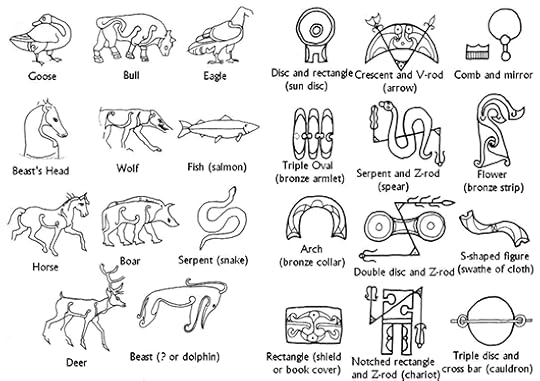 Graphic of Pictish stone symbols from the Aberdeenshire Council Website.
Graphic of Pictish stone symbols from the Aberdeenshire Council Website.The Picts left elaborately carved stones all over Scotland, and some were re-carved with beautiful crosses as they converted to Christianity. The earlier symbols like the crescent and Z rod defy modern understanding, but the animal portraits on the stones show a keen intimacy with the being portrayed—an understanding of the anatomy and movement, of the animal’s presence. The beings on the stones are representations of animals we know today: eagles, boars, deer, bulls, salmon, serpents, bears and others. There’s one exception to this earthly menagerie—the mysterious Pictish ‘beast’. This dragon-like figure is most common on Pictish stones in Northeast Scotland.
 Stylised Pictish Beast–Struthious Bandersnatch via wikimedia commons
Stylised Pictish Beast–Struthious Bandersnatch via wikimedia commonsThese stones are rare in Orkney and the Pictish beast is rarer still. In 2016 a violent storm revealed an 8th century Pictish stone wedged in a cliff face in Deerness on the east Mainland. On one side is an elaborately carved Celtic cross, with a Pictish beast on the other.
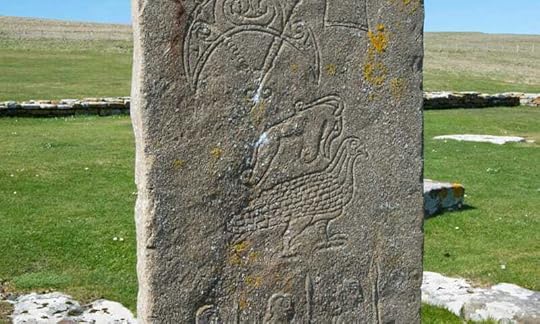 Reproduction of the Pictish Stone on Birsay via the Visit Orkney Website
Reproduction of the Pictish Stone on Birsay via the Visit Orkney WebsiteA second Pictish beast was found on a stone on the tidal island of Birsay, carved above another totemic Orkney animal—the sea eagle. Some have argued that the beast is a dragon or kelpie (a water-horse in Scottish folklore), but others see the beast as a dolphin—and I’m inclined to agree.
MariounMarioun Pardoun (also named Peblis and Peebles in the record) was executed for the crime of witchcraft in Scalloway in Shetland on the 22nd of March, 1644. She was accused of magically overturning a boat, causing four men to drown. When the bodies were found, Marioun and her husband were required to put their hands on the corpses to determine their innocence. The bodies bled and, in the logic of the time, this proved her guilt. (There is no mention of the husband in the trial record except in Marioun’s tortured reverie.) Details of her ‘waking’ or sleep deprivation were recorded, and her torturers are named—Mans Finlaysone and Jon Erasmussone. The greater the pressure they put on her, the more incoherent her confession became.
(I translate these words from Helene Willumsen’s transcription of the trial record into contemporary diction.) ‘…when they were waking her she asked where was the husband who was answering her? Speaking concerning her husband, she answered [that] he lay under her head and would not suffer her to confess.’ An accusation is noted in the margin of the trial record: Clothing your spirit with said pellock quaill. A pellock quaill is a dolphin.
 A map of the water circus Marineland in the 1980sCaptive
A map of the water circus Marineland in the 1980sCaptiveWhen I was a child I liked to listen to whale and dolphin sounds. I loved their throat songs—the clicking giggles, whistles of joy and foreboding above bass drop of deep water. I had a flexidisc from an issue of National Geographic that I played over and over on my portable turntable. When we moved from the midwest to Southern California, my father took me to Marineland to see some dolphins. It was 1986, a year before the grim place would close for good. Years after my visit, it remained a ruined, graffittied site used by locals as a makeshift skate park until it was developed into a resort. All of this is now sinking into the sea, including the 18th hole at the adjacent Trump golf course. Nostalgic, surreal reveries on Reddit are my only corroborators, with one poster using the phrase ‘fever dream’ to describe their memories of late 80s Marineland. It was once the world’s largest water circus, housing captive dolphins, orcas and seals. Orcas and pilot whales were forced to perform in tiny tanks—their lives often short and tortured. Dolphins leapt through hoops of fire and sea lions were forced to ‘sing’.
In my recollection, only my father and I are there, standing in wonder before the green murk of the empty ‘shark experience’ tank. We meander through the sun bleached park, around show tanks, their artificial blue depths mirror-still, as if before a storm. I stand alone beside the ‘Dolphin Community Tank’ and a being surfaces. She breathes. I put my hand out and touch the pale grey slip of her forehead. She looks at me and I am in the presence of a spirit clothed with pellock quaill. Her black eye takes me in–looks past to all beyond—over the walls of the park to the wide, bright sea.
Further explorations
—Tales of Pictish beasts and dolphin transformations inspired my short story, ‘Gald.’ A chance meeting in a post apocalyptic Aberdeenshire changes two young women’s lives forever. You can read it in Luna Station Quarterly, issue 40—available as a paperback and ebook: https://www.lunastationquarterly.com/issues/040/
—Take a stand against the horrific slaughter of whole pods of pilot whales and dolphins in the annual Grindadráp hunt in the Faroe Islands. Just this month, 291 pilot whales were slaughtered in the village of Leynar, including pregnant females and juveniles. Boycott tourism to the Faroe Islands and encourage others to do so. Put pressure on the Faroe Islands government to put an end to this cruel ‘tradition’ that threatens the future of the pilot whale. Find out more here (warning–this link shows footage of the hunt and contains the graphic and violent animal cruelty of the hunt.) https://seashepherd.org/faroeislands/. If you would like to take action without seeing these images, go to this page to write to officials directly.
—Dolphin photographer with the Whale and Dolphin conservation society Charlie Philips regularly records and posts beautiful images of Dolphins from the Moray Firth on Mastodon
—Laline Paul’s brilliant Pod will haunt you eternally.
—Bad Kharma at Marineland in the L.A. Times: https://www.latimes.com/california/story/2023-08-17/palos-verdes-peninsula-marineland-ocean-karma-patt-morrison
—Recovery of the Orcadian Pictish stone in Deerness: https://www.bbc.co.uk/news/uk-scotland-north-east-orkney-shetland-37798080
May 13, 2025
Renowned true crime author Carol Ann Lee has a round up o...

Renowned true crime author Carol Ann Lee has a round up of witchy. nonfiction on Bookshop.org. Her new book, Something Wicked: The Lives, Crimes and Deaths of the Pendle Witches, is just out. Of Ashes & Stones she writes:
This is a remarkable book alive with the beauty and terror of Scotland centuries earlier – as if the author reached out a hand and took the reader with her on that journey…The delicate balance between Allyson Shaw’s inner life and personal reasons for making the journey set against the stories of those whose lives were lost is beautifully rendered, while the writing throughout is sublime.
See the whole list & more about Something Wicked here: https://uk.bookshop.org/lists/carol-ann-lee-something-wicked-this-way-comes
April 27, 2025
Place writing on orkney: The Tomb of the Eagles

“I enter the tomb on something like a wide skateboard, using the rope strung from the roof of the narrow, three metre-long passageway….”
First instalment of my exploration of a place that has haunted me for 18 years—the Tomb of the Eagles. Become a paid subscriber to my blog–now hosted on Ghost.io— to read this and other exclusive posts as well as join our online Outlier Hour of writing and conversation—THIS SATURDAY! https://allysonshaw.ghost.io/inside-the-hollow-hill/
April 13, 2025
A Strange Splendour
 A vintage postcard of the surreal burn through the Cliffton’s cafeteria dining room.
A vintage postcard of the surreal burn through the Cliffton’s cafeteria dining room. What was I writing about 23 years ago? I was waxing lyrical about the high camp of a vanishing downtown Los Angeles. I published these essays in an online zine M and I edited called Die Cast Garden. I coded it using Dreamweaver made illustrations with Fireworks (before Adobe bought this software the pair were glorious, but I digress.) I found the zine on the miraculous Internet Archive’s Wayback Machine. 20 some years ago, Die Cast Garden was my answer to publishing in general—I couldn’t find an agent or publisher for my work so I made zines—xeroxed paper ones and HTML websites.
Last month, The Atlantic broke the news that Meta has used LibGen, an enormous database of copyrighted material, to train its AI, all while big publishing goes after The Internet Archive, a registered library using controlled digital lending and legal fair use.
When I look back at this work, now miraculously archived on the internet, it’s not with nostalgia but disorientation. How did we get from there—hand-coding websites that promised freedom from publishing hegemony—to this? Mega corporations indulge in piracy on a vast scale. For what?
I am playing cat and mouse: deleting X, coming off Meta, seeking an alternative to Substack. As I shuffle, it feels like disappearing.
But here is something the good internet has salvaged; may it be a boon.
 Vintage postcard of Broadway at night, downtown Los Angeles
Vintage postcard of Broadway at night, downtown Los AngelesA Strange Splendor
When I moved to Los Angeles, I refused to be at home. I couldn’t go blonde or schmooze at parties. I wouldn’t drive a car. I walked it. Almost as a dare to myself, a dare to love this sprawl of a city, I began my search for its heart, for an L.A. I could claim, an LA of spooky movie palaces and other people walking, of Cumbia and cafeteria comfort food.
The search ended downtown, in the heart of the jewelry district. I walked down Broadway and came upon the then-closed Bradbury building– it was empty and dark, still. Gray rays of sun made their way down from the glass ceiling to illuminate the lacy iron work and gorgeous red wood. It was like looking into some strange church, all delicacy and logic, its congregation vanished while outside life throbbed: salsa boomed from storefront speakers, the Giant Penny sign a modest sun, a boot seller cried “Pasale! Pasale!,” girls and old women passed hand in hand as homeless men shuffled by and a bride with her bouquet and bridesmaid made their way down Broadway to a store front which offered Marriages and Divorces.
Now, anyone can enter the Bradbury Building; light floods it. It has been refurbished it to its original grandeur. A friendly guard will give you an information sheet explaining the building’s history. The only building by architect George Wyman, his dead brother spoke through an Ouija board, and suggested he take on the project.
[The Bradbury Building was made famous as a location in Bladerunner]
We have the treasure of the Bradbury building. So many other places, parts of the city’s history, have been torn down or left to decay. Much of the older architecture downtown has been reclaimed as mini-malls or “indoor swapmeets,” elegance replaced by an overwhelming abundance. It’s a bustling marketplace where you can get anything you want, and a great deal you wouldn’t want: fake doggie doo, fresh mangos, five dollar girdles, mood lipsticks, stereo equipment, and wind up GI Joes that crawl and shoot.
In the Broadway Arcade, this array of goods so distracted me at first that I did not look up, past the vendor’s plastic canopies to see the beautiful ceiling: hundreds of smog-encrusted glass panes forming an archway overhead, unable to compete with the cavalcade of goods below. Everywhere– dark forgotten corners, whole floors of abandoned, with all the activity going on below, at street level.
The Los Angeles and Orpheum theaters still show films, but most are now storefronts, the rest of the buildings vacant. One can still see the Palace’s shabby Florentine ceilings, or the baroque Bison heads on the Million Dollar Theater, once an Evangelical church and now up for lease. The Cameo houses electronic equipment and gold; The deco Roxie and the Globe theaters are full of bargain clothing. The State is a church, the Rialto now Discount Fashion. The Tower is empty.
A year ago, Broadway was under construction. Under generations of asphalt lie railroad ties. They were revealed during excavation; this place is always becoming something else. Ingenious immigrant communities sustain it, transforming it into a place of wonder and juxtapositions. Look up: the Pre-Columbian figures on the mural at fourth and Broadway dwarf you and tower over the “Little Angels” storefront filled with frothy communion gowns. On the same scale, a 7up bulletin board from the 80’s offers sun-bleached new wave.
Like everyone else bustling about, I come to shop and eat, go to the Million Dollar Botanica where you can pick up some Good Luck Floor Wax, cowry shells or a statue of scabby Lazarus while your prescriptions are filled, or stock up on dress socks at the Sixth Street Arcade, window shop for wedding gowns and work up an appetite. Then you can go to the neon and sawdust commotion of the farmer’s market. “Since 1917,” new red banners proclaim. Load up on pupusas and Tamarindo soda and check out the watch case by the sea food.
But if you are really after comfort, walk to Clifton’s Brookdale on Broadway. Partake of its sylvan fantasy and sit down on the miniature mountain. Watch the “limeade Springs” bubble by you. Here you get a good view of both the neon cross perched atop a tiny chapel and the moose head upstairs which stares back. There’s usually entertainment on weekends. On my most recent visit I had macaroni and cheese, beets in Mayo and flan as a woman sang Spanish ballads accompanied by a man with a Casiotone. Others, who knew the songs, ate and clapped along.
But the cafeteria isn’t always wholesome. According to “cruisingforsex.com” the toilets downstairs are “cruisy”– people meet in the Robinsons May Department store and walk down to the cafeteria because “it’s safer.” I cannot back this up with personal experience.
 Vintage postcard of the waterfall facade of the Cliffton’s “Pacific Seas” location.
Vintage postcard of the waterfall facade of the Cliffton’s “Pacific Seas” location. This is not the first Clifton’s. If you visit their website, http://www.clfitonscafeteria.com, you can see many vintage postcards of the different manifestations of Clifton’s. The original “Pacific Seas”, built in the 1930’s by Clifford Clinton, is now a parking lot– the intricate tropical façade with waterfalls and tropical foliage and sign reading “Pay What You Wish” are gone. But what a cafeteria it must have been. If only I’d been alive to see the Polynesian interior with real canaries, neon palms and a “rain hut” with showers every twenty minutes. Where else in the world could you eat chipped beef in such splendour?
My favorite Clifton’s, the Silver Spoon, almost thrived underneath the Orange smoggy awning at 7th and Olive until it was closed in the late 1990’s. While not as dramatic or beautiful as the Bradbury building, it was one of my favorite places. It had soul, and now it’s gone. Clifton’s moved there in the early 1970’s, though the building dates from the twenties.
The sign outside read, “The line from the door to the register takes about eleven minutes, but it’s worth the wait!” There was never any line when I went, only a few employees and elderly patrons. The old mahogany display cases were kept intact, and downstairs they were filled with old world knick knacks, ceramic ale mugs, pastoral-scene plates, and little clogs. Upstairs in the employee break room, the cases were untouched since the building’s jewelry store days. The cases displayed yellowed illustrations of earrings, chokers and bracelets, sending off black-penned rays of light. [How did I get in there? My younger self was intrepid. I miss her.]
The place just got stranger on the lower level, or “Soupeasy,” which featured a “The Garden, a Quiet Place for Meditation,” a hold over from the Pacific Seas location. This Garden was so quiet, you needed a token from the cashier to enter. Once inside you got a glimpse of a bench and glass case. On shutting the door you’re enveloped in darkness. Eventually, the lights in the life-sized diorama come on, illuminating a wax Jesus praying in Gethsemane. A disembodied voice, just like the nasal voice in a newsreel circa 1940 begins, “In these troubled times, many have died in war, but we live…many are homeless and hungry, yet we are fed and sheltered…” And one can’t help think that just outside the streets are filled with Angelenos—some are refugees, immigrants, and the displaced who’ve fled from poverty and their own war-torn countries, now meandering through the vendor’s stalls on the street above.
How strange to sit there listening to the sanctimonious voice, just after eating a meal of macaroni and gelatin, watch the colored lights illuminate Jesus in red and green, and not see it as funny. How strange to understand the innocence of the whole project, to be in that optimism, as the yellow light turns on the head of Jesus and the speaker closes, “Like Pontius Pilot, every man must ask himself, ‘What shall I do?'” And you are left in the dark to find the door.

